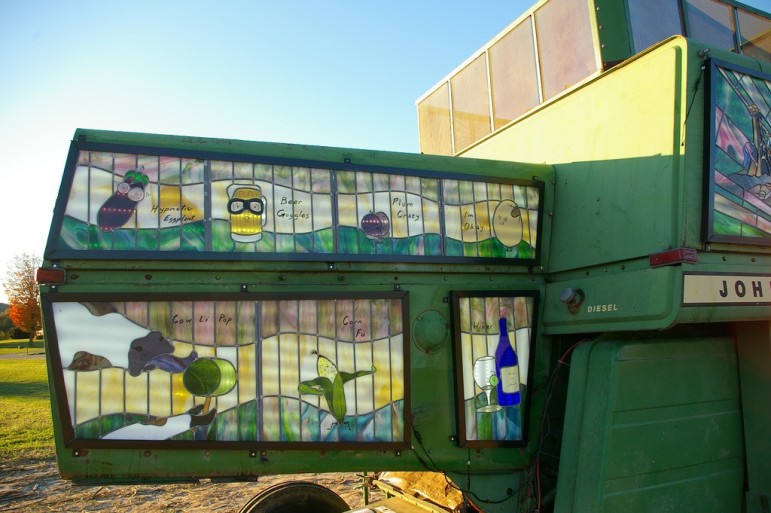
October 12, 2015; Minneapolis Star Tribune and Baraboo News Republic
“We’re in an interesting historical moment right now,” said Anne Katz, Executive Director of Arts Wisconsin. “The economy is changing and we’re living it.”
Katz, who has led the organization since 1995, said the economic crash that began in 2007 and the Great Recession that followed in 2008 and 2009 marked a turning point in the way municipal planners looked at economic development.
Marty Krueger, chairman of the Sauk County Board of Supervisors, acknowledged that grants in support of the arts result in occasional pushback from residents of Sauk County, whose population in 2010 as 61,976. The county seat and largest city is Baraboo (pop. 12,048).
“My answer to them is we cannot not afford it,” Krueger said. “This is not just a grant. It’s an investment.”
Krueger has championed “creative placemaking,” a relatively new and still evolving approach to development that links local culture and the arts with the unique attributes of a community to both grow the economy and create a better place for residents to live. The National Endowment for the Arts defines “creative placemaking” as when “public, private, not-for-profit, and community sectors partner to strategically shape the physical and social character of a neighborhood, town, tribe, city, or region around arts and cultural activities.”
To be effective, placemaking initiatives need to grow from the ground up, according to Sherry Wagner-Henry, director of the Bolz Center for Arts Administration, Wisconsin School of Business at the University of Wisconsin-Madison. Both Katz and Wagner-Henry said there’s no better local example of creative placemaking than one born in Reedsburg (pop 10,014) sitting on the Baraboo River.
Fermentation Fest and Farm/Art DTour (Fest and DTour) grew from a seed planted in 2010 when a rural Reedsburg nonprofit, the Wormfarm Institute, secured a grant to bring a Smithsonian exhibit to town. Wormfarm seeks to “build a sustainable future for agriculture and the arts by fostering vital links between people and the land.”
Sign up for our free newsletters
Subscribe to NPQ's newsletters to have our top stories delivered directly to your inbox.
By signing up, you agree to our privacy policy and terms of use, and to receive messages from NPQ and our partners.
“Planting a seed, cultivating, reaping what you sow…both farmer and artist have these activities in common,” says the organization’s website.
Now in its fifth year, Fest and DTour, a Sunday event, has begun to spread across Sauk County to places like Rock Springs (pop. 362), North Freedom (pop. 701), and farther. It’s a colorful and potent mixture of ideas, food, education, entertainment and public art that can’t be neatly boxed.
Evidence, though, suggests visitors get it and like it. Estimates for the first four years of the event show it’s growing at the rate of about 4,000 visitors per year.
“I really expect we could hit 20,000 this year,” Kristine Koenecke, executive director of the Reedsburg Area Chamber of Commerce says. “It will not surprise me. I’m preparing for that.
Koenecke said Fest and DTour has lent a unique identity to the Reedsburg area that complements those in other Sauk County municipalities. Spring Green (pop. 1,628) has the outdoor American Players Theatre, the eccentric House on the Rock, and once was home to architect Frank Lloyd Wright. Prairie du Sac (pop. 3,972) has Bald Eagle Watching Days and the Cow Chip Throw. Baraboo has a historic connection with the Ringling Bros. Circus, an annual Big Top Parade & Circus Celebration, and the historic Al Ringling Theatre.
The potent mix of arts and marketing hasn’t escaped notice in Wisconsin Dells (pop 2,678), in south-central Wisconsin. Last month, Dells officials unveiled a multi-year, $40-million plan to create a River Arts District.
The future vitality of small-town Wisconsin, says Terry Whipple, executive director of the Juneau County (pop 26,547) Economic Development Corp, rests with those who understand that creating experiences is the key to economic development. Automation means fewer people will work in traditional industry, and digital communications allow knowledge industry workers to choose where they live.
“Artists are key players in how regions grow and attract people who have choices,” argues Wormfarm Institute co-founder Donna Neuwirth. Whipple agrees: “Our main streets are changing and they’ll never return to what they once were as retail centers. They’re beginning to become our entertainment districts. Any community that is not exciting in some way—they’re dead, because they will never be able to attract or keep talent.”—John Godfrey













